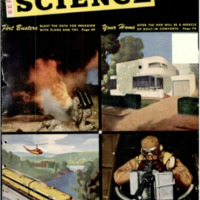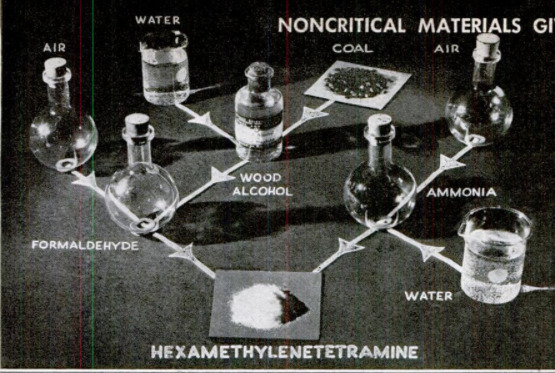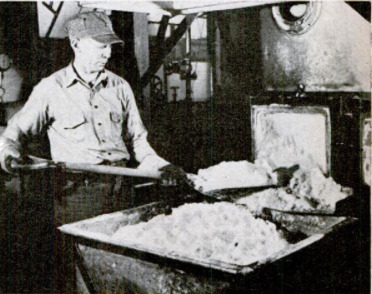More power for explosives
Item
-
Title (Dublin Core)
-
More power for explosives
-
Article Title and/or Image Caption (Dublin Core)
-
Title: Secret chemical puts more "bust" in block busters
-
extracted text (Extract Text)
-
AIR, coal, and water, broken down and
recombined by chemists, form the basic
ingredient of a new secret explosive that
daily blasts Axis war plants, naval bases,
and air fields. Known technically as hexame-
thylenetetramine-—or hexamine, for short—
this complex organic chemical has long been
used as an “accelerator” in the vulcanizing
of rubber and the making of phenol-formal-
dehyde plastics. Under the name of urotro-
pine, it also serves as a vital medicament in
the treatment of diseases of the urinary
tract. Since Pearl Harbor, however, the Du
Pont electrochemical plant, at Perth Amboy,
N. J., has been producing, for use in the new
explosive, vast quantities of specially treated
hexamine whose grain size, moisture con-
tent, and other properties are carefully con-
trolled. Resembling sugar in appearance,
hexamine is produced by a secret method of
combining liquid formaldehyde and liquid
ammonia. The resulting solution is passed
into an evaporator where it is boiled down
into a crystalline state. This substance is
then dried and ground into granulated form.
One of the virtues of hexamine is that,
unlike TNT, it requires no critical materials.
Formaldehyde is made from air and syn-
thetic wood alcohol, the latter being made
from coal and water. Synthetic ammonia is
produced from nitrogen from the air and
hydrogen from water, water gas, or coal gas.
Total production of hexamine in the U.S.
during 1941 amounted to 4,000,000 pounds.
Since then many new plants have sprung up
to increase that amount many times over,
and to insure an ample supply of the once
harmless chemical which now combines with
others to produce shattering destruction.
Just how this combining is done, of course,
must for the present be left for the chemical
wizards of the “master race” to figure out.
-
Language (Dublin Core)
-
eng
-
Date Issued (Dublin Core)
-
1943-09
-
pages (Bibliographic Ontology)
-
61
-
Rights (Dublin Core)
-
Public Domain (Google Digitized)
-
Archived by (Dublin Core)
-
Matteo Ridolfi
-
Marco Bortolami (editor)
 Popular Science Monthly, v. 143, n. 3, 1943
Popular Science Monthly, v. 143, n. 3, 1943




